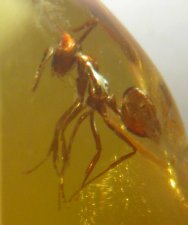Name: Fossil
Amber Insects:
Ant - Hymenoptera, Family Formicidae, Aphid - Order Homoptera, Apidoidea,
Pembigidae, Germaraphis sp.
Age: Upper
Eocene - Lower Oligocene
Size: (25.4mm=1
inch): Amber: 20 mm long , 12 mm across , 1.0 grams. Inclusions: 1-2mm
Location:
Kaliningrad District, Russia
|  Description:
This amber piece displays a fine member of the Hymenoptera. This
one is betrayed by the “elbowed” antennae as a member
of the Formicidae, or ants. The Family gets its name from the fact
that their defensive armament includes formic acid. The workers
and soldiers are exclusively sterile females; only the bloated queen
is fertile. As an unusual addition, we have a nymph of an aphid
(notice the long sucking mouthpart). Aphids are often found in association
with ants because some ants “farm” them for honeydew,
a byproduct produced by aphids. It is not known whether these two
are “farmer” and “cow”, or a chance association. Description:
This amber piece displays a fine member of the Hymenoptera. This
one is betrayed by the “elbowed” antennae as a member
of the Formicidae, or ants. The Family gets its name from the fact
that their defensive armament includes formic acid. The workers
and soldiers are exclusively sterile females; only the bloated queen
is fertile. As an unusual addition, we have a nymph of an aphid
(notice the long sucking mouthpart). Aphids are often found in association
with ants because some ants “farm” them for honeydew,
a byproduct produced by aphids. It is not known whether these two
are “farmer” and “cow”, or a chance association.
Aphids probably first appeared 280 million years
ago, in the Carboniferous when they likely fed on non-flowering
plants. They diversified into many more families with the appearance
of angiosperms some 160 millions of years ago
|
|



